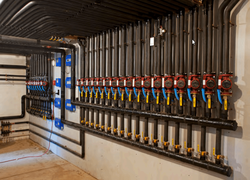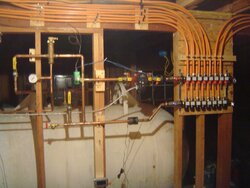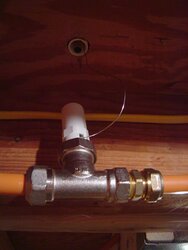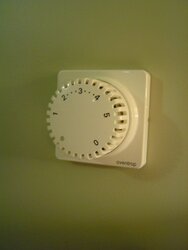Hi
I need some input on a couple of CI rads i want to place close to each other.
I want to place two 14 row CI rads end to end beside my stairs in the hall,this level of the house is open except for a bed room and bath that have their own loop.
Early in my build i had come across the info that 1/2" pex could produce 15,000 btu's,not sure if that is right.
Some other info i have is each of the 14 row CIR's will have an output of 3150 btu's at an average of 140 degree water temp.Again not sure if that is right.Originally i was sizing 20 rows per run of pex,controlled by one TRV.The manifold for runs is supplied by a Grundfoss Alph 15-55.
Anyhow are the 2 14 run rads to much load for one 1/2" pex,the manifold is about 4' from the rads?
And or if i supply each with it's own line then the one TRV will be about 3" away from the other rad.So will it function being so close to a heat source?
Thanks for any and all input.
Thomas
I need some input on a couple of CI rads i want to place close to each other.
I want to place two 14 row CI rads end to end beside my stairs in the hall,this level of the house is open except for a bed room and bath that have their own loop.
Early in my build i had come across the info that 1/2" pex could produce 15,000 btu's,not sure if that is right.
Some other info i have is each of the 14 row CIR's will have an output of 3150 btu's at an average of 140 degree water temp.Again not sure if that is right.Originally i was sizing 20 rows per run of pex,controlled by one TRV.The manifold for runs is supplied by a Grundfoss Alph 15-55.
Anyhow are the 2 14 run rads to much load for one 1/2" pex,the manifold is about 4' from the rads?
And or if i supply each with it's own line then the one TRV will be about 3" away from the other rad.So will it function being so close to a heat source?
Thanks for any and all input.
Thomas



 t circulator on small zones with cast iron radiators.(bumble bee or the like) especially if you plan to "set back " the zone. This is my 4th year with cast iron radiators.....I hope I never have to live without them in the future. Way better then "baseboard" ...witch is way better then "hot air"....witch is one step up from a camp fire...
t circulator on small zones with cast iron radiators.(bumble bee or the like) especially if you plan to "set back " the zone. This is my 4th year with cast iron radiators.....I hope I never have to live without them in the future. Way better then "baseboard" ...witch is way better then "hot air"....witch is one step up from a camp fire... +/- a degree or two, that gives me up to 25,000 Btu/hr drawing about 6 to 8 watts. When get near design temp I bump it up to speed 2 and and that gets me the 38,000 Btu/hr I need then.
+/- a degree or two, that gives me up to 25,000 Btu/hr drawing about 6 to 8 watts. When get near design temp I bump it up to speed 2 and and that gets me the 38,000 Btu/hr I need then. . Popular in Europe where they take their hydronics very seriously.
. Popular in Europe where they take their hydronics very seriously.


